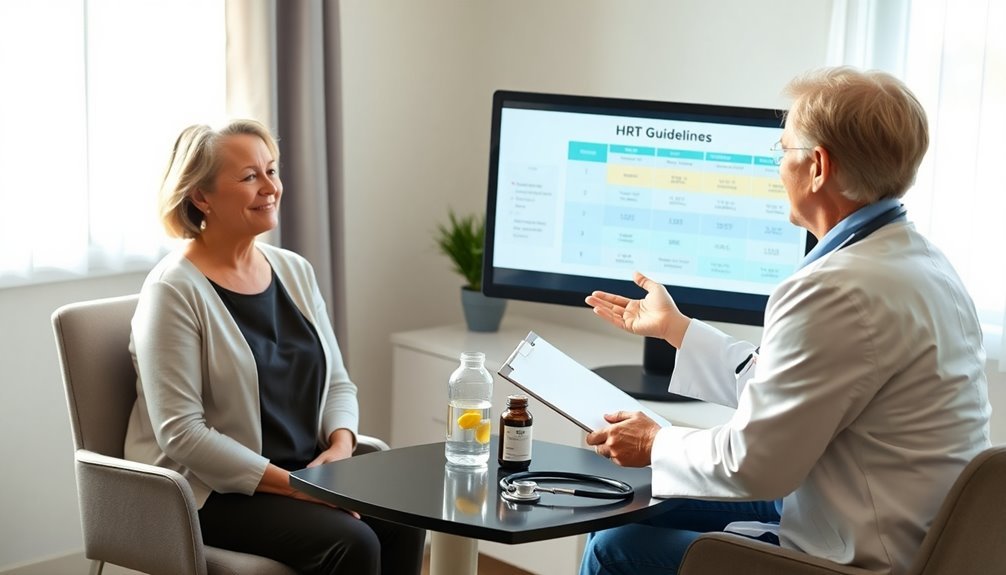When managing menopausal symptoms with Hormone Replacement Therapy (HRT), you should personalize treatment based on age, health history, and symptom severity. Choose between combined or estrogen-only HRT, considering options like oral tablets, skin patches, or vaginal rings. Regularly monitor for risks such as breast cancer or cardiovascular issues, and adjust the regimen with healthcare guidance. For added safety, complement HRT with lifestyle changes and regular provider reviews. Each HRT plan should weigh benefits like reduced osteoporosis risk and improved mood against potential side effects. Effective management involves ongoing evaluation and the exploration of alternative therapies. Discover how tailored strategies enhance benefits further.
Key Takeaways
- Tailor HRT plans to individual needs by considering medical history and symptom severity.
- Regularly monitor and adjust HRT dosage to optimize safety and symptom relief.
- Consider non-hormonal alternatives and lifestyle changes for managing symptoms if HRT is contraindicated.
- Evaluate potential risks of HRT, including breast cancer and cardiovascular disease, with healthcare providers.
- Use blood tests to customize HRT for individual hormone levels, particularly important for premature menopause.
Understanding HRT Basics

Hormone Replacement Therapy (HRT) plays a pivotal role in managing menopausal symptoms by restoring the levels of key female hormones, estrogen, and progesterone. As you approach menopause, your body experiences a hormone imbalance due to the natural decline of these hormones, leading to symptoms like hot flushes, mood swings, and vaginal dryness. HRT is specifically designed to regulate these hormone levels, providing relief from these distressing symptoms and improving your quality of life.
The process involves meticulously restoring hormone levels through various administration routes, ensuring the body's hormonal balance is maintained. Blood tests might be conducted to measure your hormone levels, especially if you're under 45 or there's suspicion of premature menopause. This helps tailor the HRT to your specific needs, ensuring effective hormone regulation. While HRT provides relief, it's important to consider health risks during menopause such as osteoporosis, which may affect your treatment decisions and overall health strategy.
However, it's essential to evaluate whether HRT is suitable for you. Some individuals may experience side effects such as headaches and bloating from the use of oestrogen and progestogen, which might warrant a review of the treatment plan. This involves considering factors such as age, symptom severity, and medical history. The decision should be a shared one between you and your healthcare provider, ensuring that the benefits outweigh the potential risks. By understanding the basics of HRT, you can make informed decisions regarding your menopausal health management.
Types of HRT
When considering hormone replacement therapy (HRT) for menopausal symptoms, it's important to understand the difference between combined and estrogen-only options, as each serves distinct purposes based on individual needs. You can choose from various administration routes, including oral tablets, skin patches, and vaginal rings, allowing for tailored treatment plans. Consuming probiotic-rich ingredients can enhance overall well-being, which might be beneficial alongside HRT. Your healthcare provider will assess your medical history to recommend the most effective and safe HRT approach for you. It is essential to weigh the benefits and risks of HRT, such as reducing hot flashes but increasing the risk of blood clots, to make an informed decision.
Combined and Estrogen-Only Options
Exploring the types of Hormone Replacement Therapy (HRT) available for managing menopausal symptoms involves understanding the nuances between combined and estrogen-only options. When deciding on combined HRT, it's vital to weigh the breast cancer risks and cardiovascular benefits. Combined HRT slightly increases the risk of breast cancer, particularly for current or recent users. However, it may offer cardiovascular benefits for women who start therapy within 10 years of menopause and are under 60, potentially reducing heart attack risks. Additionally, it provides protection against uterine cancer due to the presence of progestin. It's important to note that progestin is essential in preventing uterine cancer in some cases, making it a crucial component of combined therapy.
In contrast, estrogen-only HRT is typically recommended for women who've had a hysterectomy, as it eliminates risks of uterine cancer. Here's what you should know:
- Breast Cancer Risk: Estrogen-only HRT has a lesser association with breast cancer risk compared to combined HRT.
- Cardiovascular Benefits: It may offer heart protection, particularly for younger women starting treatment close to menopause.
- Applicability: Estrogen-only is safer for hysterectomy patients but can increase uterine cancer risk in women with an intact uterus, making it less appropriate for them.
Administration Routes Explained
Understanding how hormone replacement therapy (HRT) is administered can greatly impact both its efficacy and safety profiles for managing menopausal symptoms. Each administration route offers distinct benefits and potential drawbacks. The oral method, involving pills or tablets, is known for its metabolic benefits, such as reducing LDL cholesterol but may increase triglycerides and coagulation risk. It's suitable for women with insulin resistance or metabolic syndrome. Menopause significantly increases the risk of cardiovascular disease and osteoporosis, highlighting the importance of carefully considering HRT options.
| Route | Key Characteristics |
|---|---|
| Oral | Hepatic first-pass effect, reduces LDL, risks include heightened triglycerides |
| Transdermal | Skin patches, bypasses liver, preferred for coagulation issues, effective for symptoms |
| Vaginal | Creams, tablets, rings, targets vaginal discomfort, does not address systemic symptoms |
| Nasal/IUD | Nasal sprays, IUDs for progestin, options for endometrial concerns |
Transdermal options, such as skin patches, circumvent the hepatic first-pass, making them a viable choice for women with coagulation concerns. Vaginal routes provide targeted relief for dryness and discomfort but won't alleviate systemic menopausal symptoms. Meanwhile, nasal sprays and intrauterine devices offer alternative delivery methods with specific applications. Despite common misconceptions about menopausal hormone therapy, effectively maneuvering these routes can optimize treatment outcomes. For hormone-free options, consider lifestyle modifications, which, while not HRT, can complement medical treatments.
Individualized Treatment Plans
Although working through the complexities of hormone replacement therapy (HRT) can seem overwhelming, creating an individualized treatment plan is essential for optimizing outcomes for menopausal symptoms. Tailoring your HRT plan involves considering both your symptom severity and medical history. Here's a breakdown to guide your choices:
- Estrogen-only HRT: If you've had your womb removed, this type reduces the risk of osteoporosis and hot flashes. You'll find it in several forms like pills, patches, gels, and sprays, which can be applied via nasal spray, skin gel, or vaginal creams. This option is recommended for those without a uterus due to its low risk of endometrial cancer.
- Combined HRT (Estrogen and Progestogen): For those who still have their womb, this therapy combines estrogen and progestogen to lower endometrial cancer risk. It comes in continuous forms for post-menopausal women or sequential forms for those still menstruating.
- Cyclic vs. Combined Therapy Schedules: The choice between cyclic (monthly bleeding) and combined therapy (initial unusual bleeding) depends on your symptom severity and medical history. Cyclic therapy involves an estrogen-progestin cycle, while combined therapy involves daily intake. For added flexibility, HRT can also be administered through various forms such as a patch, gel, or implant, offering different methods of hormone delivery based on personal preference.
Always consult your healthcare provider to choose the best approach for your health needs.
Benefits of HRT

When considering Hormone Replacement Therapy (HRT) for menopausal symptoms, you'll find it offers effective relief from hot flashes, night sweats, and mood disturbances, greatly enhancing daily comfort and emotional well-being. HRT plays an essential role in reducing the risk of osteoporosis by maintaining bone density and strength, especially beneficial for women experiencing early menopause. Additionally, HRT can help maintain muscle strength, which is important for overall physical health and mobility. It is noteworthy that HRT may also improve mood regulation, potentially enhancing mental health during this transitional phase. Ultimately, HRT can improve your overall quality of life by alleviating genitourinary symptoms and enhancing sexual health, leading to a more balanced and fulfilling lifestyle.
Relief From Menopausal Symptoms
Breezing through the complexities of menopause can be challenging, but Hormone Replacement Therapy (HRT) offers a proven pathway to relief from its myriad symptoms. It's the gold standard for alleviating hot flashes and night sweats, often reducing their frequency and severity within weeks. While natural remedies and dietary changes can assist, HRT provides the most effective and immediate relief. Here's how it benefits you:
- Mood and Sleep Enhancement: HRT tackles anxiety, low mood, and mood swings linked to menopause. By improving sleep quality and reducing brain fog, it enhances cognitive function and overall life quality. Additionally, HRT can lower the risk of diabetes, providing further health benefits for women undergoing this treatment.
- Vaginal Symptom Relief: Vaginal dryness and atrophy, common menopausal issues, are effectively treated with HRT. It also reduces urinary tract infection risk when using vaginal estrogen and improves sexual function by easing dryness and discomfort.
- Additional Symptom Management: Beyond the above, HRT addresses joint pain, dry skin, nails, and eyes. It aids in weight management and can even enhance libido when combined with testosterone.
While dietary changes and natural remedies can support your journey, HRT provides targeted, evidence-based relief that addresses the multifaceted symptoms of menopause.
Lower Osteoporosis Risk
Hormone Replacement Therapy (HRT) plays a crucial role in lowering the risk of osteoporosis, a common concern during menopause. By maintaining estrogen levels, HRT provides essential hormone benefits that enhance bone health. Estrogen is key for preserving bone density, and HRT can notably build bone mineral density, especially in the spine, lumbar spine, forearm, and femoral neck. Studies show a 3.7% average increase in bone density after five years of HRT, underscoring its effectiveness in preventing bone loss and osteoporosis. Fracture prevention is another significant benefit of HRT. By sustaining estrogen levels, this therapy effectively reduces the risk of both vertebral and nonvertebral fractures, making it comparable to bisphosphonates, a well-known osteoporosis treatment. Continuous HRT therapy, when paired with adequate calcium and vitamin D intake, has a remarkable bone-sparing effect, further reducing fracture risk. Monitoring the effectiveness of HRT involves understanding its purpose and risks, as well as regular assessments to ensure it is providing the expected benefits, such as preventing fractures. Although direct comparisons with other osteoporosis treatments are limited, HRT's consistent impact on bone mineral density implies a similar reduction in fracture risk. Choosing the right osteoporosis treatment depends on individual factors like fracture risk and menopausal symptoms, but HRT remains a valuable option for those seeking both fracture prevention and menopausal symptom relief.
Improved Life Quality
Frequently, Hormone Replacement Therapy (HRT) proves to be an essential intervention for enhancing life quality during menopause. By restoring hormonal balance, HRT mitigates various menopausal symptoms, contributing significantly to enhanced well-being. It effectively addresses hot flushes, night sweats, and sleep disturbances, which can severely impact daily life.
Additionally, HRT aids in reducing anxiety and low mood, promoting a more stable emotional state. By restoring estrogen and progesterone levels, HRT also helps to prevent bone loss, which is crucial for maintaining bone density and reducing the risk of osteoporosis.
Here's how HRT can improve your quality of life:
- Reduced Physical Discomfort: HRT relieves vaginal dryness and urinary tract issues, ensuring comfort and reducing infections. This physical comfort translates to greater well-being.
- Improved Mental Health: By balancing estrogen and progesterone levels, HRT alleviates mood swings and depression, enhancing cognitive function and emotional stability. This hormonal balance is pivotal in addressing brain fog and emotional disturbances.
- Enhanced Sexual Health: HRT rejuvenates sexual desire and function by restoring reproductive hormone levels, treating vaginal dryness, and enhancing libido. This revitalization not only improves sexual health but also contributes to overall life satisfaction.
In addition, HRT offers long-term benefits like maintaining bone density and supporting cardiovascular health, further boosting overall life quality during menopause and beyond.
Considering Age Factors
When considering age factors for initiating hormone replacement therapy (HRT), assessing both the timing and individual risk profile is crucial. Age-related considerations play a pivotal role, with the average initiation age being 52, usually two years post-menopause. There's no strict age cut-off for starting or continuing HRT; however, risks increase significantly when initiating HRT after age 60 or more than 10 years post-menopause. Continuing HRT in women over 65 is possible, but it requires thorough counseling and periodic evaluations to weigh the benefits against potential risks. The majority of participants in the retrospective analysis used transdermal estrogen, highlighting its preference due to a safer profile over oral options.
The benefits of HRT in managing menopausal symptoms persist regardless of age, focusing on individual risk assessments. While HRT effectively alleviates symptoms, it shouldn't be used for the main prevention of chronic conditions in asymptomatic individuals. Age-related risk factors, such as stroke or thromboembolic events, increase with age, necessitating careful monitoring, especially in women over 60.
For older women, particularly those over 65, symptoms like hot flashes can persist, and nearly 40% in their 60s experience them. Therefore, transdermal estrogen, favored by 88% in studies, may offer a safer profile compared to oral options, enhancing quality of life while minimizing risks.
Personalizing Treatment Plans

While age factors play a significant role in deciding the timing and duration of hormone replacement therapy (HRT), tailoring treatment plans to individual hormonal profiles enhances safety and efficacy. By understanding your unique hormonal balance, healthcare providers can offer targeted hormone support that minimizes side effects and maximizes symptom relief. Estrogen levels, for instance, fluctuate notably during perimenopause, and personalized HRT can address these changes effectively. Additionally, considering cortisol and progesterone dynamics can further refine treatment plans, guaranteeing that you're not just managing symptoms but addressing their root causes.
Here's how personalized treatment plans can benefit you:
- Reduced Side Effects: Tailored HRT can minimize common issues like headaches, breast pain, and mood swings by aligning with your hormonal needs.
- Targeted Symptom Management: Specific combinations of estrogen, progesterone, and other hormones lead to more efficient relief from menopausal symptoms.
- Flexible Treatment Adjustments: As your symptoms evolve, personalized plans allow for adjustments, maintaining peak symptom relief over time.
Incorporating lifestyle changes, such as diet and exercise, alongside HRT, can further enhance your treatment outcomes. Collaborating with your healthcare provider ensures that your treatment plan is as adaptable and flexible as your needs are.
Monitoring and Safety Measures
Effective monitoring techniques are vital for ensuring the safety and effectiveness of hormone replacement therapy (HRT) for menopausal symptoms. Begin by implementing symptom tracking to evaluate improvements and any remaining symptoms post-HRT initiation. This aids in evaluating HRT adherence and whether adjustments are necessary.
The DUTCH test provides insight into estrogen detoxification pathways, highlighting patients at higher risk for adverse effects, guiding a customized treatment plan.
Risk factors evaluation is vital, particularly for those with histories of breast lumps, cancer, cardiovascular events, or other conditions increasing HRT risks. Regular physical checks, including blood pressure and weight measurements, should be part of follow-up evaluations. Conduct a risk-benefit analysis for each patient, considering any required adjustments in HRT dosage or type based on their response and side effects.
Ensure side effect reporting by instructing patients to immediately report severe symptoms like sudden headaches or speech problems. Review interactions with other medications to prevent complications. Educate patients on the importance of regular follow-ups and adherence to safety measures, such as discontinuing HRT before surgeries or extended bedrest. These thorough strategies support safe and effective HRT management.
Managing Risks and Side Effects

To effectively manage the risks and side effects of hormone replacement therapy (HRT) for menopausal symptoms, it's essential to thoroughly evaluate each patient's individual risk profile. Start by evaluating factors like age, type of HRT, duration of use, and any existing health conditions. A detailed risks assessment will guide tailored interventions. Here are some key points to take into account:
- Cancer Risks: Keep in mind that combined HRT can increase the risk of breast and ovarian cancer, especially with long-term use. Estrogen-only HRT may heighten endometrial cancer risk if you have an intact uterus.
- Cardiovascular Factors: Cardiovascular risks are more pronounced in those over 60 or if HRT is initiated over a decade after menopause. Monitor for blood clots, particularly if there's a history of cardiovascular conditions.
- Side Effects Management: Temporary side effects like headaches and mood changes may occur. While weight gain isn't directly associated with HRT, it can happen during menopause. Address vaginal dryness and night sweats with appropriate HRT formulations, and remember that HRT can help prevent bone loss, reducing osteoporosis risk.
Regular reviews with healthcare providers ensure HRT dosages are adjusted as necessary, optimizing both risk management and symptom relief.
Evaluating Alternative Therapies
When evaluating alternative therapies for menopausal symptoms, you should consider non-hormonal medication options, which include certain antidepressants and antihypertensives that have shown effectiveness in reducing hot flashes. Lifestyle adjustments, such as regular physical exercise and dietary modifications, can also notably impact symptom management, although their efficacy varies among individuals. Cognitive Behavioral Therapy (CBT) has demonstrated benefits in reducing the distress caused by hot flashes, offering a non-pharmacological approach that complements other treatments.
Non-Hormonal Medication Options
Exploring non-hormonal medication choices for menopausal symptoms can offer effective relief for those unable or unwilling to use hormone replacement therapy. The effectiveness of antidepressants plays a significant role in managing these symptoms. Venlafaxine, desvenlafaxine, and paroxetine are known for improving mood, sleep, and reducing hot flashes at low doses. However, they come with side effects like nausea and decreased libido, and some may interfere with tamoxifen. It's important to assess these factors when evaluating antidepressant effectiveness.
Other medications also provide relief:
- Gabapentin: Recognized for reducing hot flashes and aiding in sleep and anxiety management.
- Clonidine: Provides hot flash reduction but may be less potent compared to other treatments.
- Veozah (Fezolinetant): This new FDA-approved drug blocks neurokinin 3 to alleviate hot flashes but requires careful monitoring due to potential liver injury risks, emphasizing the significance of understanding its liver risk profile.
When selecting non-hormonal options, it's essential to take into account contraindications, effectiveness, and possible interactions. Before beginning any treatment, especially those like Veozah, consulting a healthcare provider for health screenings is crucial to guarantee safety.
Lifestyle Adjustments Impact
While non-hormonal medications provide a viable route for alleviating menopausal symptoms, lifestyle adjustments play an essential role in symptom management and overall well-being. By prioritizing balanced nutrition, you can greatly impact your menopause experience. Aim to consume daily recommended amounts of fruits, lean protein, vegetables, and whole grains while limiting unhealthy fats and added sugars. Incorporating calcium-rich foods and vitamin D sources into your diet supports bone health, which is pivotal during menopause. Staying hydrated by drinking sufficient water is equally important.
Regular exercise is another cornerstone of managing menopausal symptoms effectively. Engaging in 2 to 2.5 hours of moderate aerobic activity weekly, such as walking or dancing, helps with weight maintenance and mood enhancement. Incorporate weight-bearing and resistance exercises to strengthen bones and mitigate osteoporosis risk.
Incorporating stress relief techniques into your routine is crucial. Practicing meditation, yoga, and deep breathing can help reduce stress levels and enhance relaxation. Prioritize self-care, maintain regular sleep routines, and engage in activities like tai chi to support stress management. Together, these lifestyle adjustments can greatly improve your quality of life during menopause.
Cognitive Behavioral Therapy Benefits
Cognitive Behavioral Therapy (CBT) emerges as a compelling alternative for managing menopausal symptoms without the hormonal side effects associated with hormone replacement therapy (HRT). It's endorsed by the North American Menopause Society and NICE guidelines, offering a holistic approach to symptom management. CBT focuses on modifying negative thought patterns and behaviors that can worsen menopausal symptoms.
Here's how CBT can be effective:
- Reduces hot flashes: Studies demonstrate CBT's ability to decrease the frequency of hot flashes, improving your comfort considerably.
- Improves sleep disorders: CBT addresses sleep issues, enhancing sleep quality and overall restfulness.
- Boosts mood and sexual function: By employing mindfulness practices and coping strategies, CBT effectively manages depression and sexual health concerns during menopause.
CBT's flexibility is notable, as it's available in group, self-help book, and online formats. It's a short-term therapy, typically lasting four to six sessions, and is suitable for those unable to take HRT. Importantly, CBT empowers you with self-management skills, helping to reduce psychological distress and improve your quality of life long-term. Discussing with a healthcare provider can help determine if CBT is the right choice for you.
Strategies for Stopping HRT

When considering strategies for stopping hormone replacement therapy (HRT), a gradual reduction in dosage is essential to minimize withdrawal symptoms effectively. Gradual tapering of HRT over 6-12 weeks is recommended to help manage withdrawal symptoms.
You can lower the dose of your existing HRT or switch to a lower strength brand. It's vital to maintain the progestogen dose until you're ready to stop estrogen entirely. A slow withdrawal can help you avoid rebound symptoms, such as hot flushes and mood changes, which may occur if doses are reduced too quickly.
The process of stopping HRT should also consider risk reversibility. For example, the increased risk of breast cancer associated with combined HRT diminishes within five years after stopping unopposed estrogen therapy. However, it's unclear how long it takes for breast cancer risk to return to baseline after stopping combined HRT. Understanding these risks is essential as you plan your cessation strategy.
Alternating doses, like one day on and one day off, can assist in the gradual reduction process. Utilizing patches with adjustable doses might be helpful if you're finding oral HRT reductions challenging. Always consult with your healthcare provider before making changes.
Long-Term Symptom Management
As you consider long-term symptom management for menopausal symptoms, it's vital to balance the benefits and risks associated with hormone replacement therapy (HRT). Hormonal regulation plays a pivotal role in managing symptoms like hot flashes, vaginal dryness, and sleep disturbances. Regular annual reviews are essential to evaluate symptom control and identify any emerging contraindications. There's no strict limit on how long you can use HRT, provided it continues to meet treatment goals without contraindications.
Key Considerations for Long-Term Management:
- Benefits vs. Risks: While HRT reduces the risk of osteoporosis, endometrial cancer, and type 2 diabetes, long-term use can increase the risk of breast cancer, cardiovascular disease, and venous thromboembolism (VTE).
- Cardiovascular Impact: The risk of cardiovascular and cerebrovascular mortality rises if you stop HRT, emphasizing careful risk assessment.
- Individualized Approach: Tailor the type and route of HRT to your specific symptoms and health status, considering alternatives like cognitive behavioral therapy and lifestyle changes if HRT is contraindicated.
Always weigh the benefits of improved quality of life against potential health risks, ensuring that any HRT regimen aligns with your long-term health objectives.
Frequently Asked Questions
Can HRT Be Used to Treat Menopause-Related Cognitive Decline?
You can utilize hormone therapy (HRT) to address menopause-related cognitive decline, but the evidence is mixed. Initiating HRT early might aid in preserving cognitive function and memory enhancement, particularly in women aged 50-63. Observational studies reveal diverse results, indicating advantages in some instances but not in others. It's essential to take into account the type of HRT, timing, and personal health factors, as these greatly impact its effectiveness on cognitive function.
Are There Any Natural Supplements That Can Enhance the Effectiveness of HRT?
Imagine your body's hormone balance as a delicate symphony, where herbal remedies like phytoestrogens and black cohosh serve as tuning forks, enhancing HRT's effectiveness.
Studies suggest these supplements may help fine-tune your body's response to HRT by alleviating symptoms like hot flashes.
However, always consult your healthcare provider first, as these natural harmonizers aren't FDA-approved and might've interactions or side effects that need careful consideration.
How Does HRT Interact With Other Medications for Chronic Illnesses?
You must consider drug interactions and risk factors when using HRT with chronic illness medications.
HRT can alter the efficacy of epilepsy drugs like lamotrigine or phenytoin, requiring dose adjustments.
It may interact with tuberculosis meds, mood stabilizers, or cardiovascular drugs, increasing risks such as deep vein thrombosis.
Always monitor closely for changes in drug effectiveness or adverse reactions, and consult your healthcare provider for tailored advice.
Can Men Use HRT for Any Specific Health Benefits?
When contemplating hormone therapy for men's health, you'll find several potential benefits. HRT can improve mood, enhance muscle mass and bone density, boost libido, and reduce fatigue.
However, it's important to weigh these against possible risks like breast tissue growth, prostate health concerns, and infertility.
Regular monitoring and a risk-benefit assessment by a healthcare professional guarantee that the therapy aligns with your specific health needs and conditions.
Does HRT Have an Impact on Hair Loss or Growth During Menopause?
You might notice that HRT impacts hair loss and growth during menopause through hormone regulation. Estrogen in HRT supports scalp health by protecting hair and promoting growth.
However, progesterone-based treatments might disrupt the hair growth cycle, causing temporary hair loss. Fluctuating hormone levels can lead to thinning and balding.
Balancing hormone levels through HRT can improve scalp health, but effects vary. Consulting with a healthcare provider is vital for personalized treatment.
Conclusion
As you navigate menopause, remember that Hormone Replacement Therapy (HRT) can be a valuable tool. Surprisingly, studies show that HRT can reduce hot flashes by up to 75%, greatly enhancing quality of life. Tailor your treatment based on age, risks, and personal needs, always considering potential side effects. Explore alternative therapies and develop a plan for eventually stopping HRT. By doing so, you'll guarantee long-term management of menopausal symptoms, supported by evidence-based strategies.




